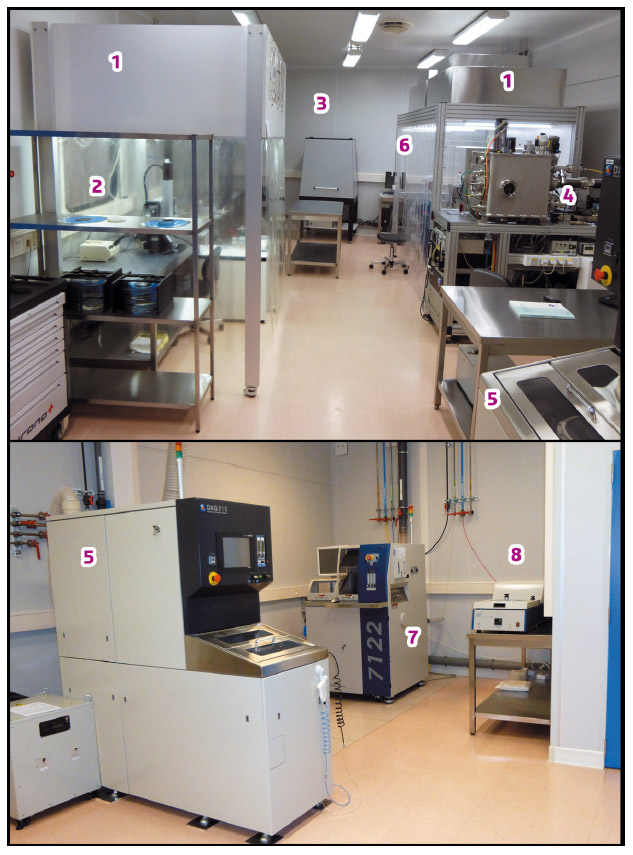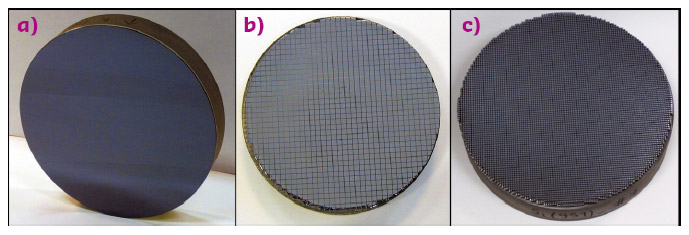- Home
- Users & Science
- Scientific Documentation
- ESRF Highlights
- ESRF Highlights 2016
- Enabling technologies
- Crystal Analyser Laboratory
Crystal Analyser Laboratory
The increasing application of hard X-ray emission spectroscopy techniques has led to a significant increase in demand for the critical optical components that permit high resolution energy discrimination of the X-ray emission signal from the sample. The ESRF has invested in a new laboratory dedicated to the development and production of these optics.
Bent analysers are optical devices for X-rays consisting of a thin single-crystal wafer bonded onto a shaped (often spherically concave) glass surface. The adhesion is normally performed with epoxy glue or by anodic bonding and the wafers are principally made from Si or Ge. Through a combination of Bragg diffraction and focusing, these analyser crystals permit a very precise measurement of X-ray energies for spectroscopic applications such as X-ray Raman spectroscopy (XRS), resonant inelastic X-ray scattering (RIXS), inelastic X-ray scattering (IXS) and emission spectroscopy (ES). There are currently six beamlines at the ESRF using spectroscopic techniques requiring the use of such crystal analysers and others are in the design phase. Most of them operate spectrometers requiring multiple analyser crystals to ensure a maximum collection solid angle. The biggest, at the ID20 beamline, has 72 spherical Si(nn0) analysers installed with curvature radius of 1 m [1].
The ESRF has been manufacturing spherical analyser crystals for many years [2]. In response to the increasing internal demand for analyser crystals for multi-analyser spectrometers, the ESRF recently built a dedicated facility for the fabrication of spherical (cylindrical) analyser crystals. The Crystal Analyser Laboratory (CAL) has been in operation since February 2015 and covers an area of roughly 120 m2 including a “clean room” of 60 m2 where the main processing tools are installed (Figure 152). The laboratory is equipped with a combination of commercial instruments (wafer grinder, wafer dicing saw) as well as in-house designed fabrication and characterisation systems (for anodic bonding, glue dispersion and inspection). In addition, the laboratory is able to draw upon the expertise and instruments of other laboratories at the ESRF, notably the Crystal Polishing and Optical Metrology laboratories. Moreover the proximity to the beamlines allows rapid performance testing of new processing technologies prior to routine production.
 |
|
Fig. 152: View of the CAL "clean room" with main processing tools. 1) Laminar flow hoods; 2) 3-axis-robot with glue dispenser; 3) Micro-interferometer; 4) Semi-automatic anodic bonding machine; 5) Grinding machine; 6) Spin coater; 7) wafer dicing saw; 8) wafer mounting machine. |
The CAL manufactures essentially three types of analyser crystals, with the different types satisfying the various experimental conditions required by our scientists in terms of energy resolution, intensity and collected solid angle. The typical diameter of the spherical glass substrate is 100 mm and the curvature radius varies from 0.5 m to 7 m. Most of the analyser crystals use Si wafers but there is an increasing demand for Ge and other single-crystal materials (e.g. quartz, lithium niobate).
The three most common types of analyser crystals which are produced are shown in Figure 153:
a) Bent analyser: Thin wafer (~200 µm) bonded to a spherical concave glass substrate by anodic bonding. Such analysers are used for applications requiring moderate energy resolution (0.4 to 1 eV).
b) Bent-diced analyser: Consists of a bent analyser with cuts providing stress relief. This improves both the energy resolution (< 0.3 eV) and the performance uniformity over the surface of the crystal.
c) Diced analyser: Thousands of Si crystal cubes glued onto a spherical concave glass substrate. All the cubes are well aligned and behave as a perfect flat crystal (stress-free). The typical cube size is ~ 0.9 mm x 0.9 mm x 2.7 mm. This analyser is used for spectroscopic studies requiring very high energy resolutions (of the order of meV).
 |
|
Fig. 153: Spherical analyser crystals of 100 mm diameter produced at CAL: a) elastically bent; b) elastically bent-diced (dicing raster 2.0 mm); c) diced with cubes size ~ 0.9 x 0.9 x 2.7 mm3. |
Since the beginning of operation, the laboratory has produced around 200 analysers of the different types for both ESRF beamlines and other laboratories worldwide. Future activity will reinforce the analyser development and concentrate upon developing techniques to extend the range of materials that can be produced (germanium, quartz, lithium niobate) as well as investigating alternative analyser geometries (van Hamos, Johansson).
Through its capacity to produce high quality analyser crystals efficiently, the new CAL laboratory is a key element towards ensuring the continuing high performance of emission spectroscopy beamlines at the ESRF. The laboratory also provides the essential infrastructure necessary for the long-term development of diverse analyser crystal geometries and systems. Further investment into production capacity is planned in the coming months.
Authors
R. Verbeni, C. Lapras, C. Cohen, M. Kocsis and R. Barrett.
ESRF
References
[1] S. Huotari et al., Journal of Synchrotron Radiation, accepted (2016).
[2] R. Verbeni et al., J. Phys. Chem. Solids 66, 2299-2305 (2005).



